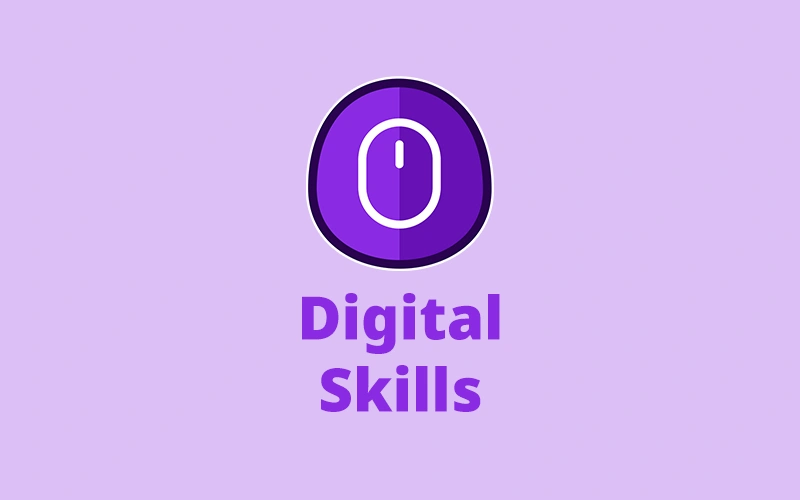In today’s technology-driven world, digital skills are no longer optional; they’re a necessity. From communicating with colleagues to managing projects and analysing data, technology has transformed the way we work. This post explores the essential digital skills you need to thrive in the modern workplace and provides practical tips on how to develop them.
Why Digital Skills Matter
Digital skills encompass a broad range of abilities related to using technology effectively and responsibly. They empower you to navigate the digital landscape, leverage technology to improve productivity, and adapt to the ever-evolving demands of the modern workplace.
Strong Digital Skills Benefit Individuals by:
- Increased Employability: Digital skills are in high demand across industries, making you a more attractive candidate to potential employers.
- Enhanced Productivity: Using technology efficiently streamlines workflows, automates tasks, and allows you to accomplish more in less time.
- Improved Communication: Digital tools facilitate seamless communication and collaboration with colleagues, clients, and stakeholders worldwide.
- Career Advancement: Mastering digital skills opens doors to new opportunities and positions you for leadership roles in the digital age.
For Organisations, Strong Digital Skills Among Employees Translate to:
- Increased Efficiency and Productivity: Employees with strong digital skills can leverage technology to optimise processes and improve overall efficiency.
- Improved Innovation and Competitiveness: A digitally skilled workforce can drive innovation, adapt to new technologies, and maintain a competitive edge.
- Better Customer Engagement: Digital skills enable businesses to connect with customers online, provide better service, and build stronger relationships.
- Data-Driven Decision Making: Employees with data analysis skills can extract valuable insights from data to inform strategic decisions.
Key Elements of Digital Skills
- Foundational Computer Skills
- Operating Systems: Proficiency in using common operating systems like Windows or macOS, including managing files, folders, and applications.
Practice: Explore the features of your operating system. Learn keyboard shortcuts, customise settings, and practice file management. - Internet and Web Browsing: Understanding how to navigate the internet, use search engines effectively, and evaluate online information critically.
Practice: Use different search engines, explore advanced search operators, and practice evaluating the credibility of online sources. - Digital Communication Tools: Effective use of email, instant messaging platforms, video conferencing tools, and social media for professional communication.
Practice: Familiarise yourself with different communication platforms and their features. Practice writing professional emails and participating in online meetings.
- Operating Systems: Proficiency in using common operating systems like Windows or macOS, including managing files, folders, and applications.
- Essential Software Proficiency
- Word Processing: Creating, editing, and formatting documents using software like Microsoft Word or Google Docs.
Practice: Create different types of documents, such as letters, reports, and presentations. Explore advanced formatting options and learn to use templates. - Spreadsheets: Using spreadsheet software like Microsoft Excel or Google Sheets to organise, analyse, and visualise data.
Practice: Create spreadsheets, use formulas and functions, and create charts and graphs to represent data visually. - Presentation Software: Developing engaging presentations using software like Microsoft PowerPoint or Google Slides.
- Practice: Create presentations with different slide layouts, incorporate visuals and multimedia, and practice delivering presentations with confidence
- Word Processing: Creating, editing, and formatting documents using software like Microsoft Word or Google Docs.
- Data and Information Management
- Data Analysis: Interpreting and drawing conclusions from data using tools and techniques to inform decision-making.
Practice: Explore data analysis tools and techniques. Practice analysing data sets and creating visualisations to identify trends and patterns. - Information Literacy: Evaluating the credibility and reliability of information sources, and using information ethically and responsibly.
Practice: Develop strategies for evaluating online information. Practice citing sources correctly and avoiding plagiarism. - Digital Security: Understanding cybersecurity threats and best practices for protecting sensitive data and online privacy.
Practice: Learn about common cybersecurity threats and how to protect yourself online. Use strong passwords, be cautious of phishing scams, and keep your software updated.
- Data Analysis: Interpreting and drawing conclusions from data using tools and techniques to inform decision-making.
- Advanced Digital Skills (Optional but Valuable)
- Digital Marketing: Knowledge of digital marketing concepts and tools can be valuable for roles involving online promotion and customer engagement.
Practice: Learn about different digital marketing channels, such as social media marketing, content marketing, and email marketing. - Project Management Software: Using tools like Asana, Trello, or Monday.com to manage projects, collaborate with teams, and track progress.
Practice: Explore different project management tools and their features. Practice creating projects, assigning tasks, and tracking deadlines. - Coding and Programming: Basic understanding of programming languages like HTML, CSS, or JavaScript can be beneficial for web development and automation tasks.
Practice: Explore online coding tutorials and resources. Start with basic HTML and CSS to understand how websites are built.
- Digital Marketing: Knowledge of digital marketing concepts and tools can be valuable for roles involving online promotion and customer engagement.
Developing digital skills is an ongoing process. By focusing on these key areas and continuously learning and adapting to new technologies, you can significantly enhance your career prospects and navigate the modern workplace with confidence.
Stay Connected: Subscribe to our newsletter and follow us on social media to get notified when new content is published. We’d love to hear from you! Share your thoughts and experiences in the comments below.

